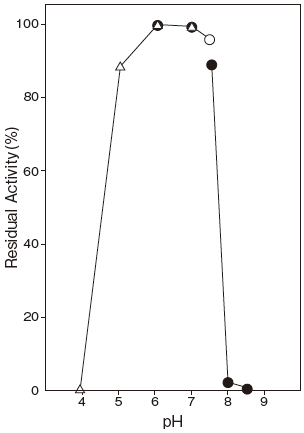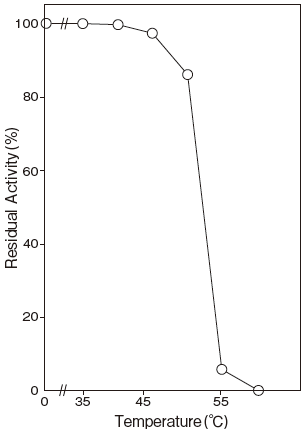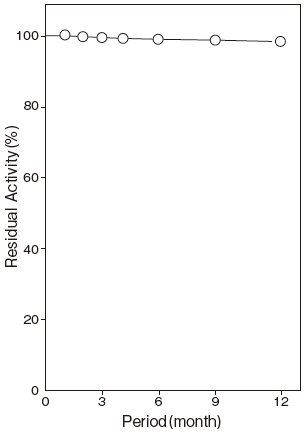PYRUVATE OXIDASE [POPG]
from Aerococcus viridans
(Pyruvate: oxygen oxidoreductase, phosphorylating, EC 1.2.3.3)
Pyruvate + Pi + O2 → Acetylphosphate + CO2 + H2O2
Preparation and Specification
- Appearance
- : Yellowish amorphous powder, lyophilized
- Specific activity
- : More than 25 U/mg solid
- Contaminants
- :
- Lactate oxidase
- Less than 0.002 % (U/U)
- Total AST (GOT)
- Less than 0.002 % (U/U)
- Total ALT (GPT)
- Less than 0.006 % (U/U)
- Catalase
- Less than 0.3 % (U/U)
Properties
- Substrate specificity
- : See Table 1
- Molecular weight
- : 155 kDa (gel filtration)
70 kDa (SDS–PAGE)
- Isoelectric point
- : pH 4.0
- Michaelis constants
- : Pyruvate 5.9 × 10-3M (Mn2+)
Pyruvate 4.1 × 10-2M (Mg2+)
Phosphate 2.0 × 10-3M (Mn2+)
Phosphate 4.5 × 10-3M (Mg2+)
- Optimum pH
- : 6.5–7.0Figure 1
- pH stability
- : 6.0–7.0 (37℃, 60 min, 10 μM FAD) Figure 2
- Optimum temperature
- : 40℃Figure 3
- Thermal stability
- : Stable at 45℃ and below (phosphate buffer containing 10 μM FAD, pH 6.5, 10 min) Figure 4
- Storage stability
- : At least one year at −20℃Figure 5
- Stabilizer
- : FAD
- Activators
- : Mn2+, Mg2+, Ca2+, Co2+
- Inhibitors
- : EDTA
- Co–factors
- : FAD, TPP
Applications for Diagnostic Test
This enzyme is useful for enzymatic determination of AST and ALT when coupled with oxaloacetate decarboxylase (T–209) (in the case of AST) and POD.
| ALT: α-KG + L-Alanine | → | L-Glutamate + Pyruvate |
| AST: α-KG + L-Aspartate | → | L-Glutamate + Oxaloacetate |
| OACⅡ | ||
| Oxaloacetate | → | Pyruvate + CO2 |
| POPG | ||
| Pyruvate + Pi + O2 | → | Acetylphosphate + CO2+ H2O2 |
| POD | ||
| 2 H2O2 + 4-AA + Phenol | → | Quinoneimine dye + 4 H2O |
Table 1. Substrate specificity
| Substrate | Relative activity (%) |
|---|---|
| Pyruvate | 100 |
| 2–Oxobutyrate | 3 |
| 2–Oxoglutarate | 0 |
| Oxaloacetate | 0 |
| DL–Lactate | 0 |
| Acetate | 0 |
| L–Alanine | 0 |
| L–Aspartate | 0 |
Fig.1 pH Optimum

Fig.2 pH Stability

〇: Phosphate buffer
●: Tris-HCI buffer containing 10 μM FAD
△: DMG-NaOH buffer
Fig.3 Optimum Temperature

Fig.4 Thermal Stability

10 mM phosphate buffer,
containing 10 μM FAD.
Fig.5 Storage (lyophilized powder)

Assay
Principle
The assay is based on the increase in absorbance at 565nm as the formation of quinoneimine dye proceeds in the following reactions:
| POPG | ||
| Pyruvate+O2+Pi | → | Acethylphosphate+CO2+H2O2 |
| POD | ||
| 2 H2O2+4–AA+DMA+H + | → | Quinoneimine dye+4 H2O |
DMA: N, N–Dimethylaniline
Unit definition
One unit is defined as the amount of enzyme which generates 1μmole of H2O2 per minute at 37℃ under the conditions specified in the assay procedure.
Reagents
- Reaction mixture Ⅰ
1 M KH2PO4 –NaOH buffer pH 6.7 0.20 ml 10 mM Thiamine pyrophosphate 0.02 ml 1 mM FAD solution 0.01 ml 100 U/ml POD solution 1) 0.05 ml 15 mM 4–AA solution 0.10 ml Distilled water 0.22 ml FAD: Flavine adenine dinucleotide 1) : 100 U/ml POD solution
Dissolve 1,000 U (PPU) of POD with 10 ml of distilled water. - Reaction mixture Ⅱ
0.2 % (V/V) DMA soultion 0.20 ml 0.1 M MgCl2solution 0.10 ml - Substrate solution
1 M Potassium pyruvate solution - Reaction stopper
McIlvaine buffer pH 5.50–5.55 containing 0.1 M EDTAEDTA: Ethylenediamine tetraacetic acid - Enzyme dilution buffer
10 mM KH2PO4–NaOH buffer pH 7.0 containing
10 μM FAD - Reagents
Thiamine pyrophosphate (Cocarboxylase) :
FUJIFILM Wako Pure Chemical Corporation#031–038334–AA: NACALAI TESQUE, INC. Special grade #01907–52
POD: Sigma Chemical Co. Type Ⅱ #P–8250
DMA: FUJIFILM Wako Pure Chemical CorporationSpecial grade #044–02763FAD (2Na) : Kyowa Hakko Co., Ltd.
Potassium pyruvate:FUJIFILM Wako Pure Chemical CorporationEDTA (2Na・2H2O) : KISHIDA CHEMICAL Co., Ltd. #060–29133
for biochemistry #166–08351
Enzyme solution
Accurately weigh about 20 mg of the sample and add enzyme dilution buffer to make a total of 20 ml. Dilute it with enzyme solution buffer to adjust the concentration as required.
Procedure
- Mix reaction mixture Ⅰ , substrate solution and reaction mixture Ⅱ in a ratio of 6 : 1 : 3. Pipette accurately 1.0 ml of the mixture into a small test tube and preincubate at 37℃.
- After 5 min, add exactly 20 μl of enzyme solution and mix to start the reaction at 37℃.
※ In the case of a test blank, add 20 μl of enzyme dilution buffer in place of enzyme solution. - At 10 min after starting the reaction, add 2.0 ml of the reaction stopper to stop the reaction.
- After 5 min, measure the absorbance at 565 nm.
△A = (As−Ab) ≦ 0.400 AbsAbsorbance sample : As blank : Ab
Calculation
Activity (U/mg of powder) = {(△A/10) /(23.56×1/2)}× 3.02/0.02 × 1/x| 23.56 : | millimolar extinction coefficient of quinoneimine dye at 565 nm ( cm2 /μmole) |
| 1/2 : | a multiplier derived from the fact that 2 mole of |
H2O2 produces 1 mole of quinoneimine dye 10 : reaction time (min) 3.02 : final volume (ml) 0.02 : volume of enzyme solution (ml) X : concentration of the sample in enzyme solution ( mg/ml)
Storage
Storage at −20℃ in the presence of a desiccant is recommended. Enzyme activity will be retained for at least one year under this condition (Figure 5) .
References
- Harger, L. P., Geller, D. M. and Lipmann, F. (1954) Fed.
Proc., 13, 734–738. - Lipmann, F. (1940) J. Biol. Chem., 134, 463–464.
- Harger, L. P. and Lipmann, F. (1955) Methods Enzymol.,
Vol. 1, 482. - Sedewitz, B., Schleifer, K. H. and Gotz, F. (1984) J.
Bacteriol., 160, 273–278. - Sedewitz, B., Schleifer, K. H. and Gotz, F. (1984) J.
Bacteriol., 160, 462–465.
POPG 活性測定法 (Japanese)
試薬液
- 反応試薬混合液Ⅰ
1M KH2PO4 – NaOH 緩衝液pH6.7 0.20 ml 精製水 0.22 ml 15mM 4–AA 溶液 0.10 ml 100U/ml POD 溶液 1) 0.05 ml 10mM チアミンピロリン酸溶液 0.02 ml 1mM FAD 溶液 0.01 ml 1) : 100U/ml POD 溶液
POD 1,000 単位 (PPU) を精製水10ml で溶解する。 - 反応試薬混合液Ⅱ
0.2% (V/V) DMA 溶液 0.20 ml 0.1M 塩化マグネシウム溶液 0.10 ml - 基質溶液
1M ピルビン酸カリウム溶液 - 反応停止液
0 . 1M E D T A を含むマックイルバイン緩衝液
pH5.50~5.55 - 酵素溶解希釈用液
10 μ M FAD を含む10mM KH2PO4 – NaOH 緩衝液pH7.0 - 試薬
チアミンピロリン酸 (コカルボキシラーゼ) :富士フイルム和光純薬製 #031–03833POD: シグマ製 Type Ⅱ #P–8250
4–AA: ナカライテスク製 特級 #01907–52
DMA (N,N’– ジメチルアニリン) :富士フイルム和光純薬製 特級 #044–02763FAD (フラビンアデニンジヌクレオチド・2Na) :協和発酵製
- ピルビン酸カリウム:
富士フイルム和光純薬製 生化学用 #166–08351
EDTA (エチレンジアミン四酢酸・2Na・2H2O) :キシダ化学製 #060–29133
酵素試料液
- 検品約20mg を精密に量り、酵素溶解希釈用液で溶解して全容20ml とする。
その液を酵素溶解希釈用液で適宜希釈する。
測定操作法
- 反応試薬混合液Ⅰと基質溶液及び反応試薬混合液Ⅱを6:1:3 に混合し、その混合液1.0ml ずつを正確に小試験管へ分注して37℃で予備加温する。
- 5 分経過後、酵素試料液20 μl を加えて混和し、37℃で反応を開始する。
※ 盲検は酵素試料液の代わりに酵素溶解希釈用液20μl を加える。 - 10 分経過後、反応停止液2.0ml を加えて混和し、反応を停止する。
- 5 分後、565nm における吸光度を測定する。
求められた吸光度を試料液はAs、盲検液はAb とする。
ΔA= (As−Ab) ≦ 0.400 Abs
計算
活性 (U/mg) = {(ΔA/10)/ (23.56 × 1/2)}× 3.02/0.02 × 1/x| 23.56 : | キノンイミン色素の565nm におけるミリモル分子吸光係数 (cm2 / μmole) |
| 1/2 : | H2O2 2 モルからキノンイミン色素1 モルが生成することによる係数 |
| 10 : | 反応時間 (min) |
| 3.02 : | 反応総液量 (ml) |
| 0.02 : | 反応に供した酵素試料液量 (ml) |
| X : | 酵素試料液中の検品濃度 (mg/ml) |
